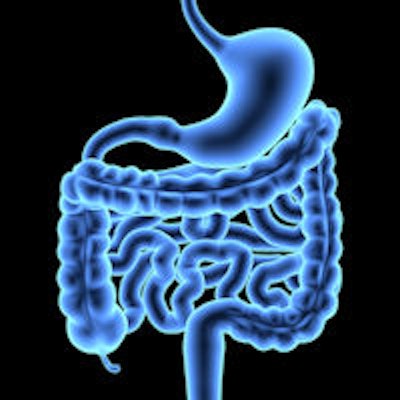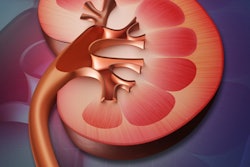
Extracolonic findings are relatively uncommon in CT colonography (CTC) screening, but the few that require follow-up tend to be highly significant to the patient's health, according to a new report in the American Journal of Roentgenology.
An eight-year study of nearly 8,000 adults who underwent first-time screening CTC followed up on the most significant extracolonic findings -- those classified as E4 in the CT Colonography Reporting and Data System (C-RADS). Although E4 findings were limited to 2.5% of screening subjects, they were potentially very serious, including about one-fourth with malignant or potentially malignant neoplasms, and even more with potentially serious vascular findings such as abdominal aortic aneurysms (AJR, February 2016, Vol. 206:2, pp. 313-318).
"When we looked at patients with the most severe category of potentially important extracolonic findings, we found that this group comprised only about 2.5% of our patients, but within this group almost 70% of them ended up with clinically significant diagnoses that required some sort of treatment or surveillance," lead author and radiology resident Dr. B. Dustin Pooler from the University of Wisconsin told AuntMinnie.com. "Finding these things sooner rather than later could have been a benefit to them."
Concerns about extracolonic findings
CT colonography finds significant polyps and cancers at the same rate as optical colonoscopy; however, it also detects abnormalities outside the colon, and how to deal with these findings is still under debate as CTC proponents seek widespread Medicare reimbursement for screening. There are concerns about the potential frequency with which these findings lead to further workup, increasing patient cost and anxiety for things that could turn out to be benign.
 Dr. B. Dustin Pooler from the University of Wisconsin.
Dr. B. Dustin Pooler from the University of Wisconsin.Prior studies have not substantiated these fears, but they also have not completely addressed the question of which serious findings occur and with what frequency. Some studies did not include a purely screening cohort, for example, or were performed with IV contrast, while others included symptomatic patients, thus "limiting the generalizability to CTC in the context of screening for colorectal cancer," the authors wrote. Other studies lumped E3 and E4 findings together, or focused on a particular type of finding such as cancer.
"Because the detection of disease outside the colon is unavoidable, a more complete understanding of the frequency and nature of extracolonic findings is critical to placing into context the benefits and costs of screening CTC as a whole -- specially if it is to be implemented on a larger scale -- as well as in developing guidelines and recommendations for particular extracolonic findings," Pooler and colleagues wrote.
The current study analyzed the most clinically important extracolonic findings in the screening population. Exclusion criteria included a history of colorectal cancer, inflammatory bowel disease, polyposis syndromes, or a history of colorectal surgery.
In all, there were 7,952 consecutive adults (3,675 men, 4,277 women; mean age, 56.7 years) who underwent first-time screening CTC between 2004 and 2012. All exams were read prospectively, with extracolonic findings recorded and categorized. The most important findings were reviewed retrospectively with additional analysis or follow-up.
Images were acquired on 8- to 64-detector-row CT scanners at 1.25-mm collimation, a 1-mm reconstruction interval, 120 kVp, and either a fixed tube current of 50 mAs to 75 mAs or tube-current modulation from 30 mA to 300 mA. Images were reconstructed at 3-mm intervals and viewed on a standalone workstation (V3D Colon, Viatronix) using 3D reconstructions and 2D cross-sectional images.
C-RADS, developed in 2006, categorizes extracolonic findings on a scale from E0 (risk unknown) and E1 through E4, the latter being the most serious type of finding requiring definite follow-up. E2 findings are considered unimportant, and E3 findings are considered probably insignificant but worthy of careful consideration subject to local practice.
Few serious findings
Overall, 2.5% (202/7,952) of patients had a potentially significant extracolonic finding designated as C-RADS category E4. Additional imaging was recommended for 113 patients, or 56%, with clinical follow-up recommended for 89 patients, or 44%.
After accounting for 22 patients lost to follow-up, 68% (123) of the remaining 180 patients had clinically significant disease, including 23% (42) with malignancy or potentially malignant neoplasms and 32% (57) with abdominal aortic or other visceral artery aneurysms requiring treatment or surveillance.
The most commonly involved organs were the vascular system, the genitourinary system, the liver, the gastrointestinal system, the lungs, and the gynecologic system.
| Organs and systems involved in E4 findings | ||
| Vascular system | 26% | 53/202 |
| Genitourinary system | 18% | 36/202 |
| Liver | 15% | 30/202 |
| Gastrointestinal system | 9.9% | 20/202 |
| Lungs | 9.4% | 19/202 |
| Gynecologic system | 6.9% | 14/202 |
Significant unsuspected vascular aneurysms were confirmed in 26% (46/180) of patients, including 22 abdominal aortic aneurysms 3 cm or larger, 11 common iliac aneurysms 1.5 cm or larger, and 13 other visceral abdominal aneurysms. Other significant conditions not previously diagnosed were seen in 19% (35/180) of patients, including obstructive or staghorn urolithiasis in eight, intestinal malrotation in seven, polycystic kidney disease in five, cirrhosis of the liver in four, sarcoidosis in three, and endometriosis in two patients.
The remaining 32% (57/180) of E4 patients had findings that were ultimately proved benign. Of these, 81% (46/57) were found to be benign after additional imaging or clinical follow-up. Only 6.1% (11/180) of patients with E4 findings underwent surgery or biopsy to prove benign disease, representing a very small number of patients receiving unnecessary interventions.
"Often lost in the discussion of extracolonic findings is the magnitude and rate of beneficial diagnoses that would otherwise remain unsuspected," the authors wrote.
C-RADS category E4 represents the extracolonic findings most likely to harbor these important diagnoses, and it included 40% of all patients who received a workup.
At an average age of 60.5 years, patients with E4 findings were significantly older than the average patient (56.7 years, p < 0.0001), which is understandable considering the positive correlation between age and many of the malignancies reported.
In all, 68% of patients with E4 findings in this study proved to have clinically significant disease after workup, and just 32% were found to be benign, the authors wrote. Vascular aneurysms were the single most commonly seen disease category, found in 0.58% of the total cohort (46 patients).
Unsuspected E4 findings are uncommon, Pooler and colleagues concluded.
"However, when encountered they are high yield, representing a diverse spectrum of clinically significant pathologic abnormalities requiring treatment or continued surveillance," they wrote.
Finding important but silent disease should be seen as an additional benefit of screening CTC, they added. Both surgery and invasive biopsy were avoided in most patients whose findings proved benign.
"Given the large percentage of findings that turn out to need clinical attention, we feel that this definitively represents an additional benefit beyond the intended benefit of [CTC] screening," Pooler said. "This represents the most important group of extracolonic findings, and we're happy to have done a thorough analysis of them."
To complete the picture, the authors are looking to analyze E3 findings as well, Pooler said.




















